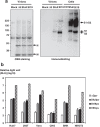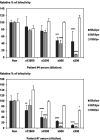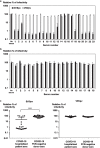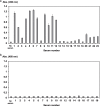Evaluation of SARS-CoV-2 neutralizing antibodies using a vesicular stomatitis virus possessing SARS-CoV-2 spike protein
- PMID: 33435994
- PMCID: PMC7801864
- DOI: 10.1186/s12985-021-01490-7
Evaluation of SARS-CoV-2 neutralizing antibodies using a vesicular stomatitis virus possessing SARS-CoV-2 spike protein
Abstract
Background: SARS-CoV-2 is a novel coronavirus that emerged in 2019 and is now classified in the genus Coronavirus with closely related SARS-CoV. SARS-CoV-2 is highly pathogenic in humans and is classified as a biosafety level (BSL)-3 pathogen, which makes manipulating it relatively difficult due to its infectious nature.
Methods: To circumvent the need for BSL-3 laboratories, an alternative assay was developed that avoids live virus and instead uses a recombinant VSV expressing luciferase and possesses the full length or truncated spike proteins of SARS-CoV-2. Furthermore, to measure SARS-CoV-2 neutralizing antibodies under BSL2 conditions, a chemiluminescence reduction neutralization test (CRNT) for SARS-CoV-2 was developed. The neutralization values of the serum samples collected from hospitalized patients with COVID-19 or SARS-CoV-2 PCR-negative donors against the pseudotyped virus infection evaluated by the CRNT were compared with antibody titers determined from an enzyme-linked immunosorbent assay (ELISA) or an immunofluorescence assay (IFA).
Results: The CRNT, which used whole blood collected from hospitalized patients with COVID-19, was also examined. As a result, the inhibition of pseudotyped virus infection was specifically observed in both serum and whole blood and was also correlated with the results of the IFA.
Conclusions: In conclusion, the CRNT for COVID-19 is a convenient assay system that can be performed in a BSL-2 laboratory with high specificity and sensitivity for evaluating the occurrence of neutralizing antibodies against SARS-CoV-2.
Keywords: Neutralization assay; Pseudotyped virus; SARS-CoV-2; Serum; VSV; Whole blood.
Conflict of interest statement
The authors declare no conflicts of interest in association with the present study.
Figures





References
Publication types
MeSH terms
Substances
Grants and funding
LinkOut - more resources
Full Text Sources
Other Literature Sources
Medical
Research Materials
Miscellaneous

